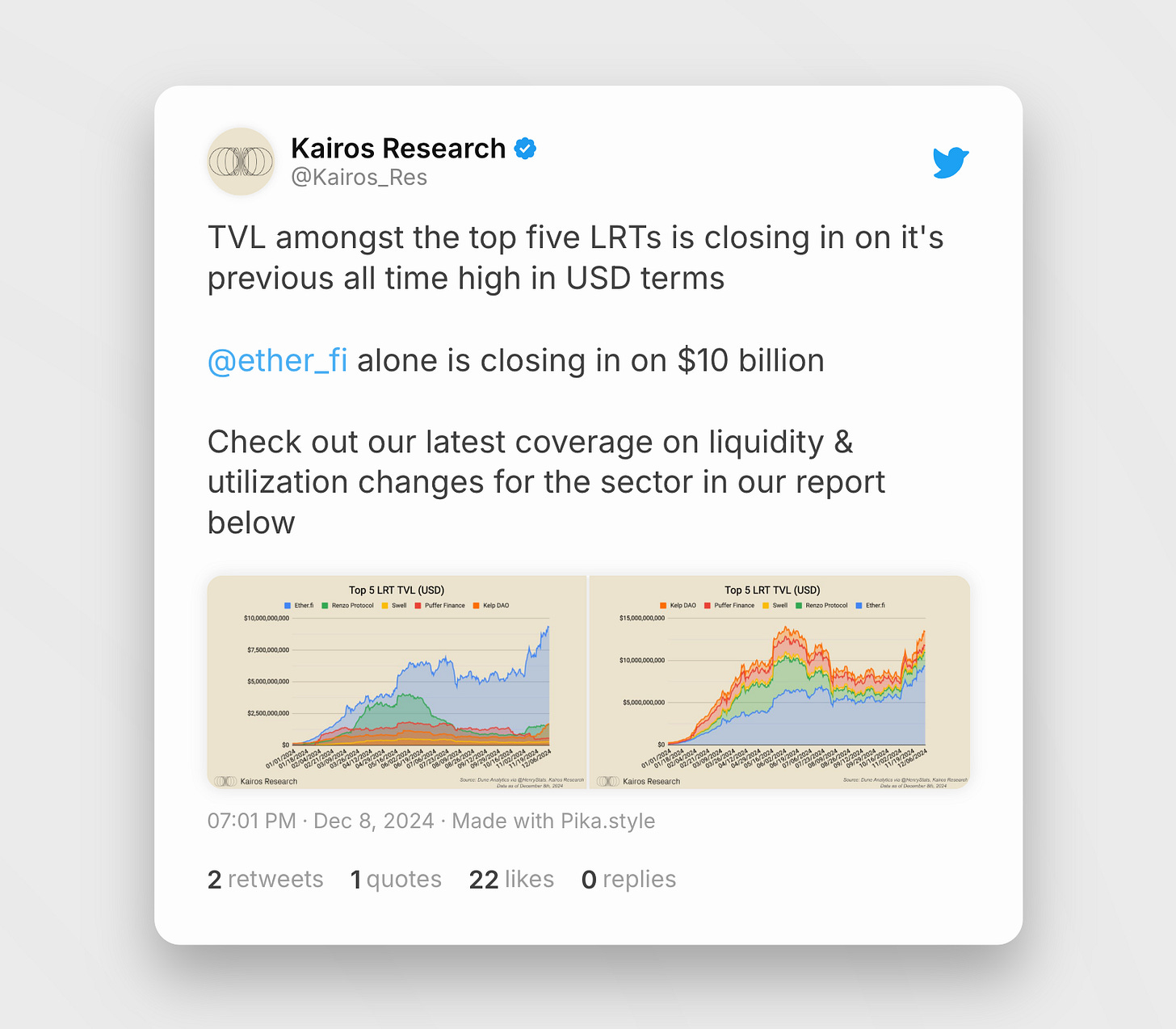Re:Staking Weekly #5
Work Payments, LRTs' TVL Coming Back to All-Time High, and New Restaking Economic Research
GM friends 👋
Welcome to this week’s Re:Staking Weekly.
This week, we're going deep into the weeds of rewards, taking a leap from the stake-proportional reward structure to the new work payments. How will this change AVS design? What are the advantages of these updates, and are there any drawbacks?
Additionally, we have updates from EigenLayer about its Protocol Council, new economic research, and opportunities to earn EigenLayer rewards from Binance Academy.
Let's go!
Rewards Just Got Better
EigenLayer is introducing work payments.
Rewards were one of EigenLayer's breakthrough features when it launched a few months ago. When it launched, I was excited because it meant restaking was finally becoming real. Not only could capital be put to work, but you'd actually get paid for it.
The V1 rewards system was pretty basic, mirroring the traditional Proof-of-Stake model: for example, distributing $1,000 among operators and their restakers between December 1-25 based on stake proportions (there are customizable weights for different restaking assets, but let's not get lost in the weeds).
While this traditional approach has served PoS systems well, work payments are now pushing the boundaries of what's possible and introducing entirely new design paradigms.
Work payments give services unprecedented control over reward distribution. They can implement nuanced reward structures – think rewarding the fastest operator with 50% of the rewards pool, second place with 25%, third with 12.5%, and so on.
This marks a fundamental shift: rather than distributing rewards uniformly based on stake, networks can now incentivize operators who excel at specific performance metrics.
This is a big deal. If you caught the Food for Thought section in our last issue, you'll recognize how combining slashing and soft-slashing with work payments creates countless possibilities for tailored network incentives, hence a true modular architecture – one that is not confined to a single consensus and incentive mechanism, but rather a combination of many.
The idea of different systems working together to achieve a complex goal represents a fundamental departure from building a one-size-fits-all networks. While it's certainly a big leap into the future - one that requires significant developer and user education to fully realize its potential (given that we only have 2 services launching rewards, we still have a long way to go) - I'm pumped to see this version of the future nonetheless.
Read the announcement here.
News Bites
Eigen Foundation introduces the Protocol Council, a key piece in its governance mechanism.
LRT TVL is closing in on its previous all time high, from Kairos Research.
New research from Brett Palatiello, Head of Economic Research at Eigen Labs, explains the relationship between slashable stakes, stake syncing, and task completion. read more here.
Gauntlet’s new research on stable coin based restaking model
EigenLayer launches user testing program.
You can now participate in EigenLayer quest and earn rewards on Binance Academy.
Restaking in Numbers

With 27 AVSs now on Mainnet, we're in for a wild ride in Q1 2025 as these services launch their tokens and go to market! Now restaking is looking more like a proper ecosystem rather than just a DeFi product.
Food for Thought
Despite work payments creating more granular control over network setup, it's also true that from a user's perspective, the burden to understand what's going on with each AVS has increased significantly. While current AVSs don't all share the same design, and as the restaking architecture grows more sophisticated, tools and utilities will help bring these technical details into broad daylight. Still, it seems that support for proper evaluation of these AVS designs remains far off and isn't keeping pace with infrastructure updates.
Additionally, work payments make operator delegation a lot more challenging. Previously, you might have been able to make stake delegation decisions at a whim, but now you're forced to examine each operator set's reward criteria and its fitness with your desired operator. What's certain to emerge are advanced operator delegation strategies for particular AVSs. The big question is: will this disrupt the LRT landscape?
That's it for this week's newsletter! As always, feel free to send us a DM or comment directly below with your thoughts or questions.
If you want to catch up with the latest news in the restaking world, give our curated X list a follow!
See you next week and thanks for reading,









